Multi-Agent Decision-Making in Construction Engineering and Management: A Systematic Review
Abstract
1. Introduction
2. Materials and Methods
2.1. Search Rules
- Topics were scanned with the search rule mentioned above in the Web of Science database for 1 January 2012 to 6 January 2023 and the language of English. This rule retrieved 645 papers (including articles, proceedings papers, editorials, and reviews).
- The abstract of each paper was read to exclude irrelevant ones. Finally, 137 papers were selected for the literature review.
- Papers in conference proceedings and editorials were rejected, leaving 105 articles.
2.2. Bibliometric Approach
3. Bibliometric Analysis
3.1. Journals
3.2. Years
3.3. Countries and Territories
3.4. Co-Occurrence Analysis
4. Critical Review
- (1)
- Primary concerns for multi-agent decision-making in CEM.
- (2)
- Tools and methods to do multi-agent decision-making in practice.
- (3)
- Research tools and methods of multi-agent decision-making in CEM.
- (4)
- Key points to solving multi-agent decision-making problems.
4.1. Main Concerns for Multi-Agent Decision-Making in CEM
4.1.1. Safety Management
4.1.2. Green and Low Carbon
4.1.3. Design Management
4.1.4. Dynamic Planning
4.2. Tools and Methods to Do Multi-Agent Decision-Making in Practice
4.2.1. BIM Technologies
4.2.2. Data Information Technology
4.2.3. Off-Site Construction
4.2.4. Extended Reality
4.3. Research Tools and Methods of Multi-Agent Decision-Making in CEM
4.3.1. Network Perspective
4.3.2. Simulation
4.3.3. Game Theory
4.3.4. Multi-Criteria Decision-Making
4.4. Key Points to Solve Multi-Agent Decision-Making Problems
4.4.1. Collaboration
4.4.2. Collaborative Innovation
4.4.3. Trust
4.4.4. Incentives
4.4.5. Performance Evaluation
5. Future Research Directions
5.1. Knowledge Management
5.2. Resilience
5.3. Methodological Development
6. Conclusions
Supplementary Materials
Author Contributions
Funding
Conflicts of Interest
References
- Yang, Y.; Shao, B.; Jin, L.; Zheng, X. Collaborative Governance of Tower Crane Safety in the Chinese Construction Industry: A Social Network Perspective. Buildings 2022, 12, 836. [Google Scholar] [CrossRef]
- Zhilyaev, D.; Binnekamp, R.; Wolfert, A.M.R. Best Fit for Common Purpose: A Multi-Stakeholder Design Optimization Methodology for Construction Management. Buildings 2022, 12, 527. [Google Scholar] [CrossRef]
- Jiang, S.; Wei, X.; Jia, J.; Ma, G. Toward sustaining the development of green residential buildings in China: A tripartite evolutionary game analysis. Build. Environ. 2022, 223, 109466. [Google Scholar] [CrossRef]
- Liang, R.; Dong, Z.; Sheng, Z.; Wang, X.; Wu, C. Case Study of Selecting Decision-Making Schemes in Large-Scale Infrastructure Projects. J. Infrastruct. Syst. 2017, 23, 06017001. [Google Scholar] [CrossRef]
- Cheng, J.C.P.; Chen, K.; Chen, W. State-of-the-Art Review on Mixed Reality Applications in the AECO Industry. J. Constr. Eng. Manag. 2020, 146, 03119009. [Google Scholar] [CrossRef]
- Li, W.; Yuan, J.; Zhang, G.; Wei, S.; Zhang, B.; Skibniewski, M.J. Agent-Based Simulation Modeling for the Evaluation and Dynamic Adjustment of Project Benefits in Urban Rail Transit PPPs. J. Manag. Eng. 2023, 39, 04022074. [Google Scholar] [CrossRef]
- Song, X.; Peña-Mora, F.; Shen, C.; Zhang, Z.; Xu, J. Modelling the effect of multi-stakeholder interactions on construction site layout planning using agent-based decentralized optimization. Autom. Constr. 2019, 107, 102927. [Google Scholar] [CrossRef]
- Mooselu, M.G.; Nikoo, M.R.; Bakhtiari, P.H.; Rayani, N.B.; Izady, A. Conflict resolution in the multi-stakeholder stepped spillway design under uncertainty by machine learning techniques. Appl. Soft Comput. 2021, 110, 107721. [Google Scholar] [CrossRef]
- Prabhakaran, A.; Mahamadu, A.-M.; Mahdjoubi, L.; Boguslawski, P. BIM-based immersive collaborative environment for furniture, fixture and equipment design. Autom. Constr. 2022, 142, 104489. [Google Scholar] [CrossRef]
- Marzouk, M.; Thabet, R. A BIM-Based Tool for Assessing Sustainability in Buildings Using the Green Pyramid Rating System. Buildings 2023, 13, 1274. [Google Scholar] [CrossRef]
- Tavakolan, M.; Mohammadi, S.; Zahraie, B. Construction and resource short-term planning using a BIM-based ontological decision support system. Can. J. Civ. Eng. 2021, 48, 75–88. [Google Scholar] [CrossRef]
- Zhai, W.; Ding, J.; Wang, Z.; Ding, L. Performance and Participants Decisions Analysis in Major Water Resources Allocation Project Based on Network Governance. Water Resour. Manag. 2022, 36, 2455–2470. [Google Scholar] [CrossRef]
- Wang, H.; Zhao, Y.; Gao, X.; Gao, B. Collaborative decision-making for urban regeneration: A literature review and bibliometric analysis. Land Use Policy 2021, 107, 105479. [Google Scholar] [CrossRef]
- Jensen, P.A.; Maslesa, E.; Berg, J.B.; Thuesen, C. 10 questions concerning sustainable building renovation. Build. Environ. 2018, 143, 130–137. [Google Scholar] [CrossRef]
- Ferretti, V.; Degioanni, A. How to support the design and evaluation of redevelopment projects for disused railways? A methodological proposal and key lessons learned. Transp. Res. Part D Transp. Environ. 2017, 52, 29–48. [Google Scholar] [CrossRef]
- Pirzadeh, P.; Lingard, H.; Blismas, N. Effective communication in the context of safe design decision making. Saf. Sci. 2020, 131, 104913. [Google Scholar] [CrossRef]
- Mirzaei-Zohan, S.A.; Gheibi, M.; Chahkandi, B.; Mousavi, S.; Khaksar, R.Y.; Behzadian, K. A new integrated agent-based framework for designing building emergency evacuation: A BIM approach. Int. J. Disaster Risk Reduct. 2023, 93, 103753. [Google Scholar] [CrossRef]
- Rahmani, F. Challenges and opportunities in adopting early contractor involvement (ECI): Clients perception. Archit. Eng. Des. Manag. 2021, 17, 67–76. [Google Scholar] [CrossRef]
- Jeschke, K.N. Understanding how managers balance the paradoxical nature of occupational safety through a practice-driven institutional lens. Saf. Sci. 2022, 147, 105627. [Google Scholar] [CrossRef]
- Zhang, J.; Wu, C.; Wang, Y.; Ma, Y.; Wu, Y.; Mao, X. The BIM-enabled geotechnical information management of a construction project. Computing 2018, 100, 47–63. [Google Scholar] [CrossRef]
- Ramshani, M.; Li, X.; Khojandi, A.; Omitaomu, O. An agent-based approach to study the diffusion rate and the effect of policies on joint placement of photovoltaic panels and green roof under climate change uncertainty. Appl. Energy 2020, 261, 114402. [Google Scholar] [CrossRef]
- Tezel, A.; Koskela, L. Off-site construction in highways projects: Management, technical, and technology perspectives from the United Kingdom. Constr. Manag. Econ. 2023, 41, 475–499. [Google Scholar] [CrossRef]
- Khaddour, L.A. Life-cycle sustainability risk management a multi-stakeholder approach: The case of Damascus post-war residential projects. Environ. Dev. Sustain. 2022, 24, 12756–12786. [Google Scholar] [CrossRef]
- Chenya, L.; Aminudin, E.; Mohd, S.; Yap, L.S. Intelligent Risk Management in Construction Projects: Systematic Literature Review. IEEE Access 2022, 10, 72936–72954. [Google Scholar] [CrossRef]
- Wang, S.-Y.; Lee, K.-T.; Kim, J.-H. Green Retrofitting Simulation for Sustainable Commercial Buildings in China Using a Proposed Multi-Agent Evolutionary Game. Sustainability 2022, 14, 7671. [Google Scholar] [CrossRef]
- Pan, Y.; Zhang, L.; Skibniewski, M.J. Clustering of designers based on building information modeling event logs. Comput. Aided Civ. Infrastruct. Eng. 2020, 35, 701–718. [Google Scholar] [CrossRef]
- Li, Y.; Wang, G.; Zuo, J. Assessing Green-Building Policies with Structural Consistency and Behavioral Coherence: A Framework of Effectiveness and Efficiency. J. Constr. Eng. Manag. 2021, 147, 04021149. [Google Scholar] [CrossRef]
- Vakaj, E.; Cheung, F.; Cao, J.; Tawil, A.-R.H.; Patlakas, P. An Ontology-Based Cost Estimation for Offsite Construction. J. Inf. Technol. Constr. 2023, 28, 220–245. [Google Scholar] [CrossRef]
- Stracchi, P.; Cardellicchio, L.; Tombesi, P. Not really an aftermath. The role of actual construction in the design process of the Sydney Opera House roof. Front. Archit. Res. 2023, 12, 242–265. [Google Scholar] [CrossRef]
- Du, J.; Jing, H.; Castro-Lacouture, D.; Sugumaran, V. Multi-agent simulation for managing design changes in prefabricated construction projects. Eng. Constr. Archit. Manag. 2019, 27, 270–295. [Google Scholar] [CrossRef]
- Liu, N.; Zhou, G. Analysis of collaborative innovation behavior of megaproject participants under the reward and punishment mechanism. Int. J. Strateg. Prop. Manag. 2022, 26, 241–257. [Google Scholar] [CrossRef]
- Pramono, R.W.D.; Palupi, L.; Aditya, R. Urban Development Project Evaluation Using Multi-Stakeholder Cost–Benefit Analysis. Int. Rev. Spat. Plan. Sustain. Dev. 2022, 10, 240–259. [Google Scholar] [CrossRef] [PubMed]
- Coelho Dos Santos, F.; Marques Carvalho, M.T.; Gomes De Oliveira Brandstetter, M.C. Tool for the integration of building performance information within the BIM process. Rev. De La Construcción 2022, 21, 645–656. [Google Scholar] [CrossRef]
- Durdyev, S.; Ashour, M.; Connelly, S.; Mahdiyar, A. Barriers to the implementation of Building Information Modelling (BIM) for facility management. J. Build. Eng. 2022, 46, 103736. [Google Scholar] [CrossRef]
- Sharafat, A.; Khan, M.S.; Latif, K.; Seo, J. BIM-Based Tunnel Information Modeling Framework for Visualization, Management, and Simulation of Drill-and-Blast Tunneling Projects. J. Comput. Civ. Eng. 2021, 35, 04020068. [Google Scholar] [CrossRef]
- Tsai, S.L.; Ochiai, C.; Tseng, M.H.; Deng, C.Z. A framework for NGO-led post-disaster reconstruction programs in the indigenous community: A case study of the 2009 Typhoon Morakot in Taiwan. Int. J. Disaster Risk Reduct. 2022, 73, 102879. [Google Scholar] [CrossRef]
- Bolshakova, V.; Guerriero, A.; Halin, G. Identifying stakeholders roles and relevant project documents for 4D-based collaborative decision making. Front. Eng. Manag. 2020, 7, 104–118. [Google Scholar] [CrossRef]
- Kubicki, S.; Guerriero, A.; Schwartz, L.; Daher, E.; Idris, B. Assessment of synchronous interactive devices for BIM project coordination: Prospective ergonomics approach. Autom. Constr. 2019, 101, 160–178. [Google Scholar] [CrossRef]
- Rodrigues, F.; Alves, A.D.; Matos, R. Construction Management Supported by BIM and a Business Intelligence Tool. Energies 2022, 15, 3412. [Google Scholar] [CrossRef]
- Wu, L.; Lu, W.; Chen, C. Strengths and weaknesses of client-server and peer-to-peer network models in construction projects. Int. J. Constr. Manag. 2023, 24, 1349–1363. [Google Scholar] [CrossRef]
- Dong, J.; Meng, W.; Liu, Y.; Ti, J. A framework of pavement management system based on IoT and big data. Adv. Eng. Inform. 2021, 47, 101226. [Google Scholar] [CrossRef]
- Elghaish, F.; Abrishami, S.; Abu Samra, S.; Gaterell, M.; Hosseini, M.R.; Wise, R. Cash flow system development framework within integrated project delivery (IPD) using BIM tools. Int. J. Constr. Manag. 2021, 21, 555–570. [Google Scholar] [CrossRef]
- Truong, P.; Hölttä-Otto, K.; Becerril, P.; Turtiainen, R.; Siltanen, S. Multi-User Virtual Reality for Remote Collaboration in Construction Projects: A Case Study with High-Rise Elevator Machine Room Planning. Electronics 2021, 10, 2806. [Google Scholar] [CrossRef]
- Senaratne, S.; Rodrigo, M.; Jin, X.; Perera, S. Current Trends and Future Directions in Knowledge Management in Construction Research Using Social Network Analysis. Buildings 2021, 11, 599. [Google Scholar] [CrossRef]
- He, L.; Yuan, H.; Wu, H. Collaborative mechanism for promoting the cross-regional management of construction and demolition waste. J. Clean. Prod. 2022, 372, 133706. [Google Scholar] [CrossRef]
- Yoon, J.H.; Pishdad-Bozorgi, P. Game Theory-Based Framework for Analyzing the Collaborative Dynamic of Tacit Knowledge Sharing and the Choice of Procurement and Contract Types in Mega Construction Projects. Buildings 2022, 12, 305. [Google Scholar] [CrossRef]
- Asghari, V.; Wang, Y.; Biglari, A.J.; Hsu, S.-C.; Tang, P. Reinforcement Learning in Construction Engineering and Management: A Review. J. Constr. Eng. Manag. 2022, 148, 03122009. [Google Scholar] [CrossRef]
- Rahmawati, Y.; Utomo, C.; Zawawi, N. BIM and E-Negotiation Practices in AEC Consulting Businesses. Sustainability 2019, 11, 1911. [Google Scholar] [CrossRef]
- Li, X.; Shen, G.Q.; Wu, P.; Yue, T. Integrating Building Information Modeling and Prefabrication Housing Production. Autom. Constr. 2019, 100, 46–60. [Google Scholar] [CrossRef]
- Wuni, I.Y.; Shen, G.Q. Critical success factors for management of the early stages of prefabricated prefinished volumetric construction project life cycle. Eng. Constr. Archit. Manag. 2020, 27, 2315–2333. [Google Scholar] [CrossRef]
- Liu, Y.; Yao, F.; Ji, Y.; Tong, W.; Liu, G.; Li, H.X.; Hu, X. Quality Control for Offsite Construction: Review and Future Directions. J. Constr. Eng. Manag. 2022, 148, 03122003. [Google Scholar] [CrossRef]
- Hussein, M.; Karam, A.; Eltoukhy, A.E.E.; Darko, A.; Zayed, T. Optimized multimodal logistics planning of modular integrated construction using hybrid multi-agent and metamodeling. Autom. Constr. 2023, 145, 104637. [Google Scholar] [CrossRef]
- Karamoozian, M.; Hong, Z. Using a decision-making tool to select the optimal industrial housing construction system in Tehran. J. Asian Archit. Build. Eng. 2023, 22, 2189–2208. [Google Scholar] [CrossRef]
- Xu, H.; Chang, R.; Pan, M.; Li, H.; Liu, S.; Webber, R.J.; Zuo, J.; Dong, N. Application of Artificial Neural Networks in Construction Management: A Scientometric Review. Buildings 2022, 12, 952. [Google Scholar] [CrossRef]
- Pérez Hernández, M.; Puchkova, A.; Parlikad, A.K. Multi-Agent Learning of Asset Maintenance Plans through Localised Subnetworks. Eng. Appl. Artif. Intell. 2024, 127, 107362. [Google Scholar] [CrossRef]
- Asheghi, R.; Hosseini, S.A.; Saneie, M.; Shahri, A.A. Updating the neural network sediment load models using different sensitivity analysis methods: A regional application. J. Hydroinform. 2020, 22, 562–577. [Google Scholar] [CrossRef]
- Lin, J.-R.; Wu, D.-P. An approach to twinning and mining collaborative network of construction projects. Autom. Constr. 2021, 125, 103643. [Google Scholar] [CrossRef]
- Heikinheimo, M. Paimio Sanatorium under Construction. Arts 2018, 7, 78. [Google Scholar] [CrossRef]
- Robles, C.; Rangel, E.; Sánchez, N. Material supply planning and management model for social housing projects in a construction company. Rev. Ing. De Construcción 2022, 37, 185–200. [Google Scholar] [CrossRef]
- Yap, J.B.H.; Leong, W.J.; Skitmore, M. Capitalising teamwork for enhancing project delivery and management in construction: Empirical study in Malaysia. Eng. Constr. Archit. Manag. 2020, 27, 1479–1503. [Google Scholar] [CrossRef]
- Abbaszadeh Shahri, A.; Chunling, S.; Larsson, S. A hybrid ensemble-based automated deep learning approach to generate 3D geo-models and uncertainty analysis. Eng. Comput. 2024, 40, 1501–1516. [Google Scholar] [CrossRef]
- Su, Y. Multi-agent evolutionary game in the recycling utilization of construction waste. Sci. Total Environ. 2020, 738, 139826. [Google Scholar] [CrossRef]
- Fredriksson, A.; Janné, M.; Nolz, P.; De Radiguès De Chennevière, P.; Van Lier, T.; Macharis, C. Creating stakeholder awareness in construction logistics by means of the MAMCA. City Environ. Interact. 2021, 11, 100067. [Google Scholar] [CrossRef]
- Kpamma, Z.E.; Adjei-Kumi, T.; Ayarkwa, J.; Adinyira, E. Choosing by Advantages incorporated framework for a user-involved design process. Archit. Eng. Des. Manag. 2018, 14, 194–217. [Google Scholar] [CrossRef]
- Marzouk, M.; Daour, I.A. Planning labor evacuation for construction sites using BIM and agent-based simulation. Saf. Sci. 2018, 109, 174–185. [Google Scholar] [CrossRef]
- Han, X.; Yan, W.; Lu, M. Research on the coordination mechanism of major industrial project engineering and construction multi-agents based on structural holes theory. PLoS ONE 2021, 16, e0255858. [Google Scholar] [CrossRef]
- Zhang, N.; Hwang, B.-G.; Deng, X.; Tay, F. Collaborative contracting in the Singapore construction industry: Current status, major barriers and best solutions. Eng. Constr. Archit. Manag. 2020, 27, 3115–3133. [Google Scholar] [CrossRef]
- Sun, C.; Wang, M.; Zhai, F. Research on the Collaborative Application of BIM in EPC Projects: The Perspective of Cooperation between Owners and General Contractors. Adv. Civ. Eng. 2021, 2021, 4720900. [Google Scholar] [CrossRef]
- Zhang, N.; Hwang, B.-G.; Deng, X.; Tay, F. Exploring critical success factors for collaborative contracting implementation in the Singapore construction industry. Eng. Constr. Archit. Manag. 2022, 31, 919–938. [Google Scholar] [CrossRef]
- Xia, W.; Li, B.; Yin, S. A Prescription for Urban Sustainability Transitions in China: Innovative Partner Selection Management of Green Building Materials Industry in an Integrated Supply Chain. Sustainability 2020, 12, 2581. [Google Scholar] [CrossRef]
- Alleman, D.; Stanford, M.S.; Papajohn, D.; Jobidon, G.; Molenaar, K.R. Characteristics of Stipends and Their Value-Adding Potential in Design-Build US Highway Construction. J. Leg. Aff. Disput. Resolut. Eng. Constr. 2020, 12, 04520011. [Google Scholar] [CrossRef]
- Timm, J.F.G.; Maciel, V.G.; Passuello, A. Green public procurement model for environmental assessment of constructive systems. Int. J. Constr. Manag. 2023, 23, 718–728. [Google Scholar] [CrossRef]
- Zhao, N.; Ying, F.J.; Tookey, J. Knowledge visualisation for construction procurement decision-making: A process innovation. Manag. Decis. 2022, 60, 1039–1055. [Google Scholar] [CrossRef]
- Tjebane, M.M.; Musonda, I.; Okoro, C. Organisational Factors of Artificial Intelligence Adoption in the South African Construction Industry. Front. Built Environ. 2022, 8, 823998. [Google Scholar] [CrossRef]
- Singh, V.; Sharma, S.K. Critical factors of multi-agent technology influencing manufacturing organizations: An AHP and DEMATEL-oriented analysis. Int. J. Comput. Integr. Manuf. 2024, 37, 243–265. [Google Scholar] [CrossRef]
- Ghavami, S.M.; Maleki, J.; Arentze, T. A multi-agent assisted approach for spatial Group Decision Support Systems: A case study of disaster management practice. Int. J. Disaster Risk Reduct. 2019, 38, 101223. [Google Scholar] [CrossRef]
- Le, P.L.; Elmughrabi, W.; Dao, T.-M.; Chaabane, A. Present focuses and future directions of decision-making in construction supply chain management: A systematic review. Int. J. Constr. Manag. 2020, 20, 490–509. [Google Scholar] [CrossRef]
- Bensalah, M.; Elouadi, A.; Mharzi, H. Overview: The opportunity of BIM in railway. Smart Sustain. Built Environ. 2019, 8, 103–116. [Google Scholar] [CrossRef]
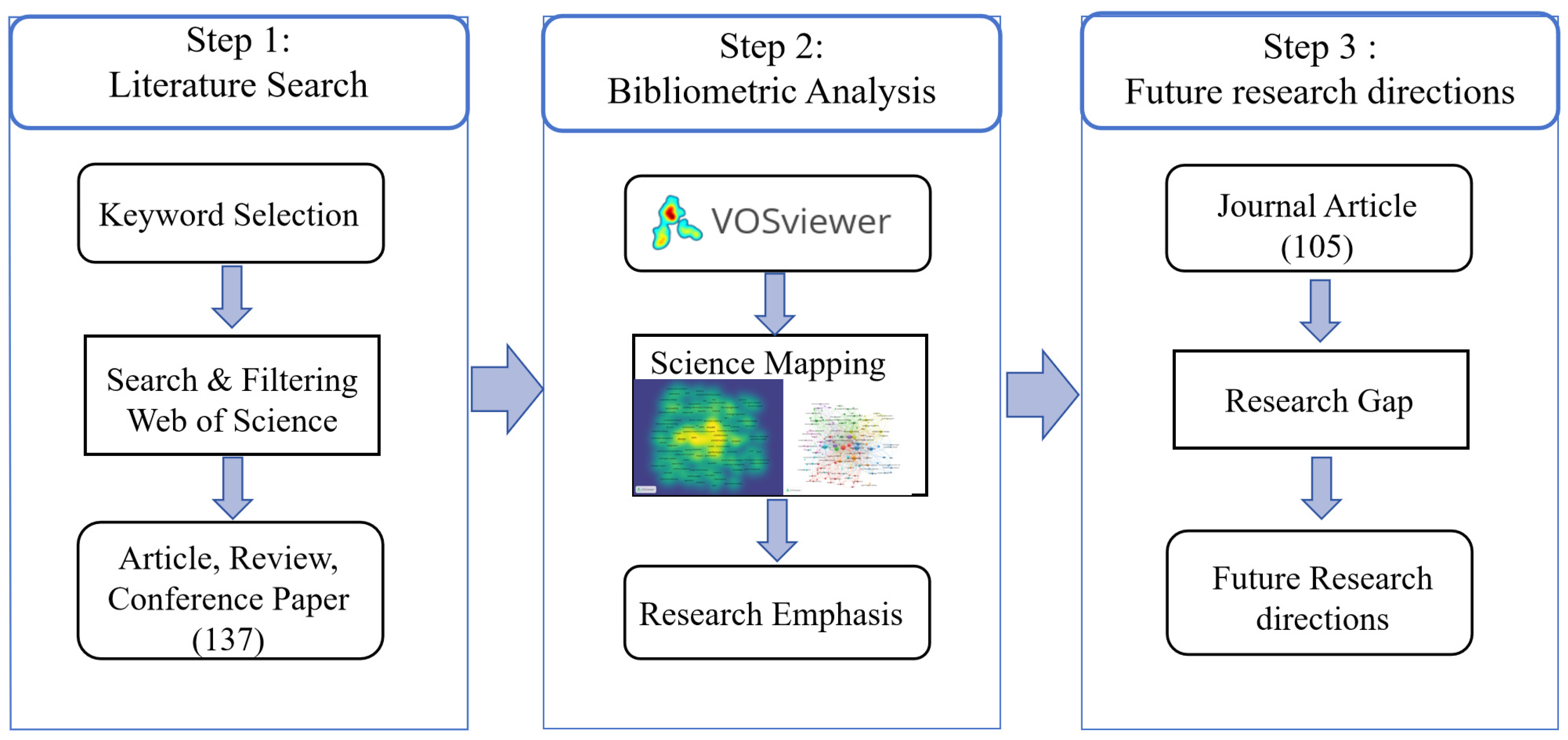
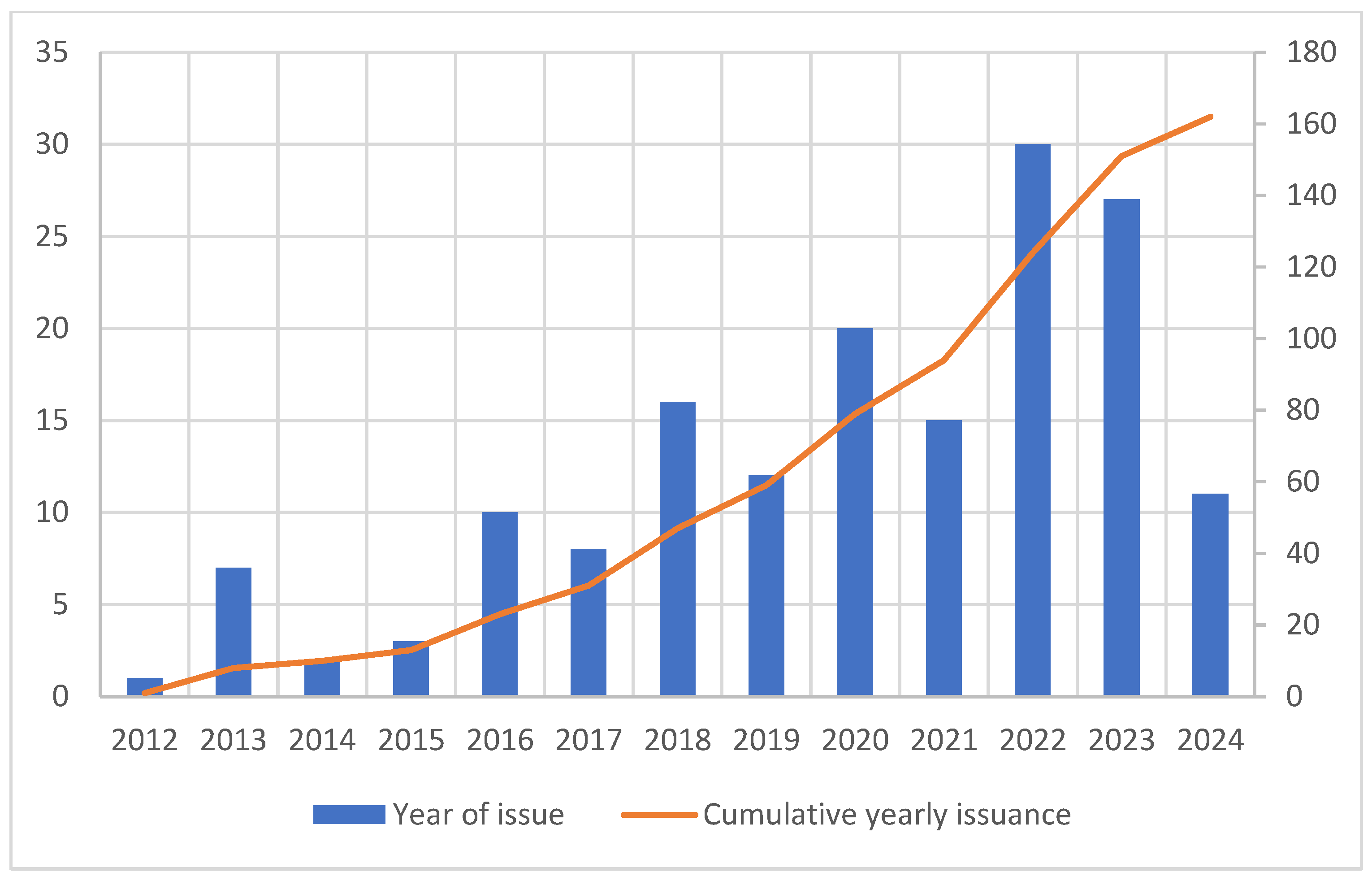

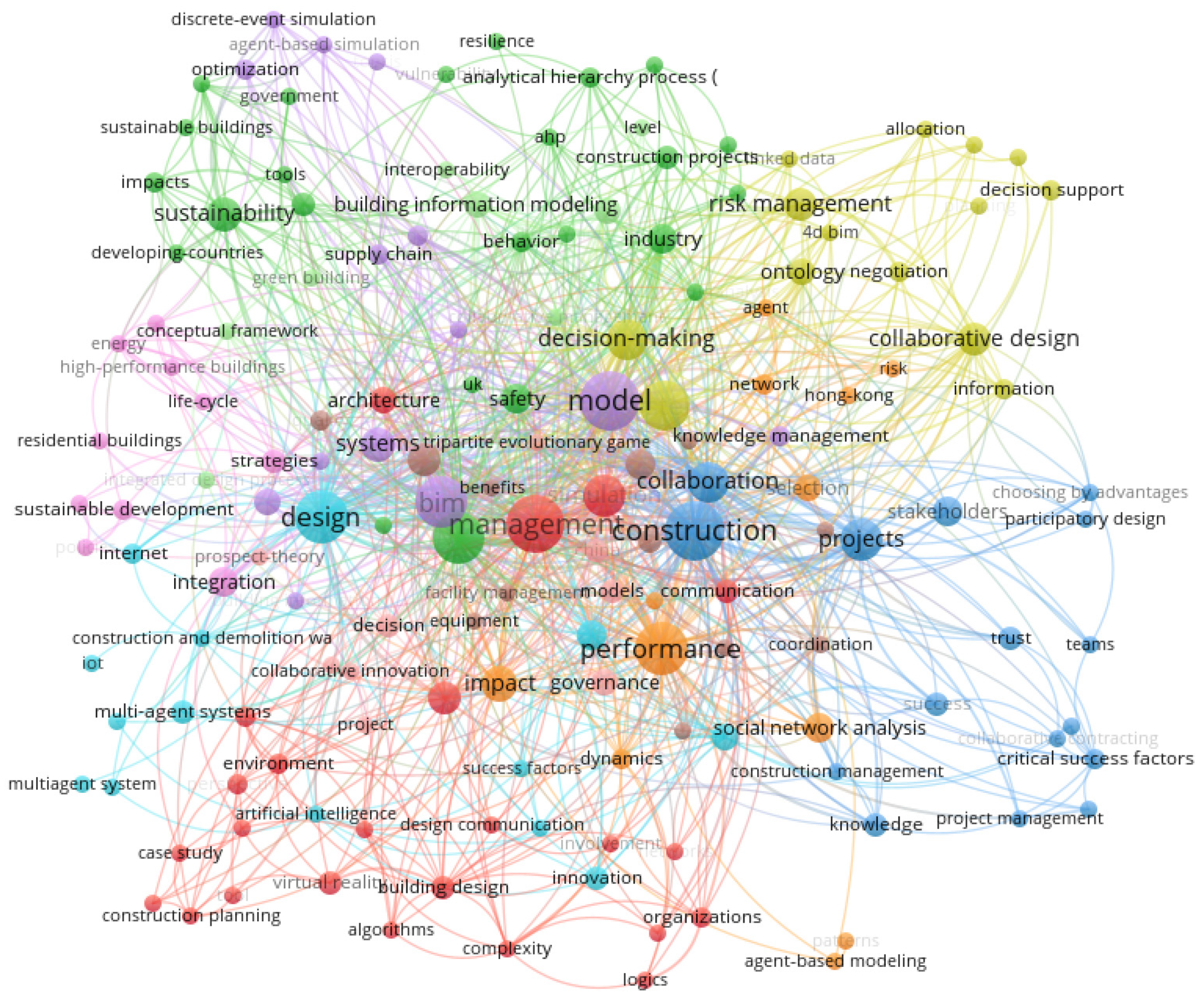
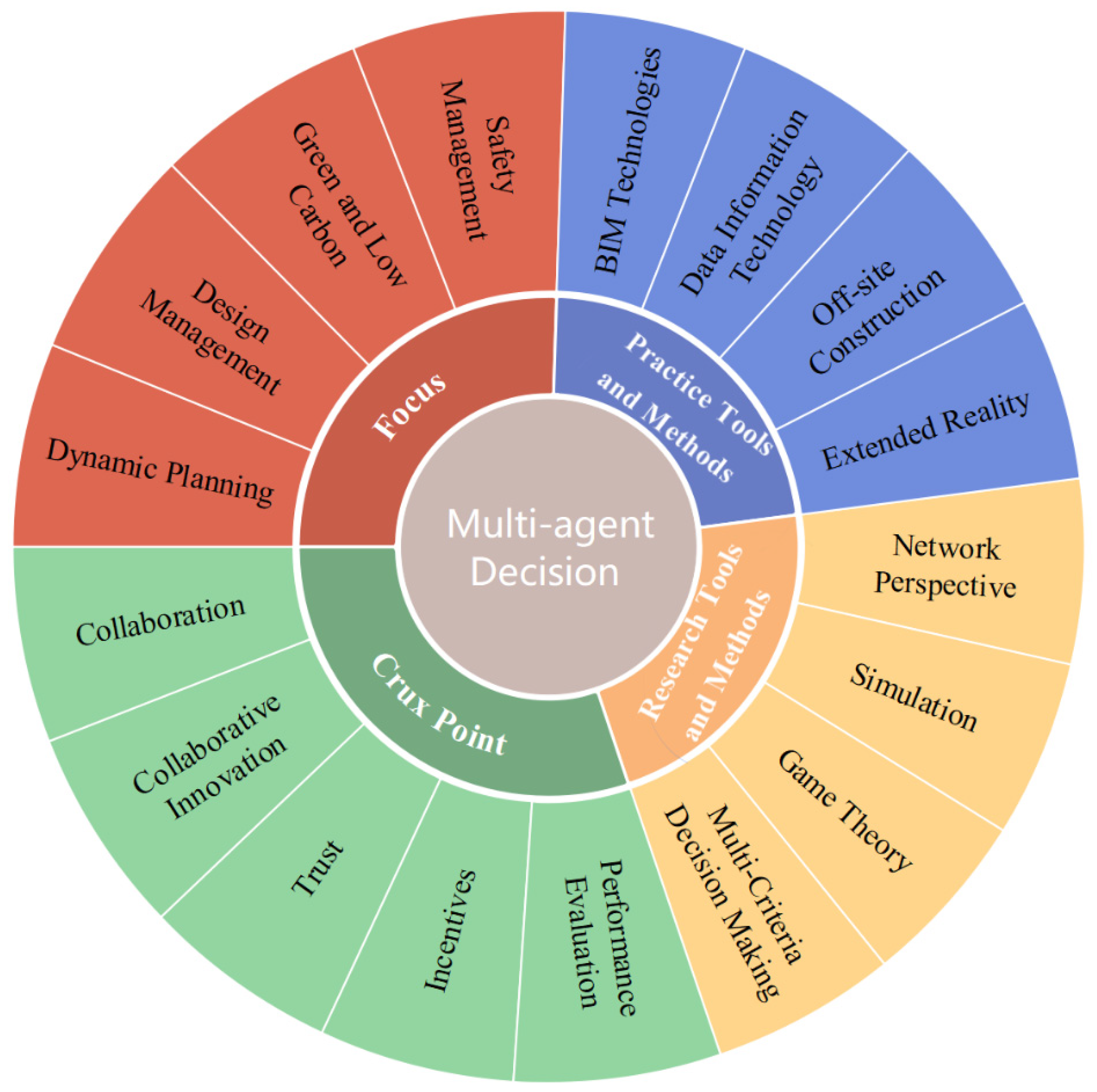
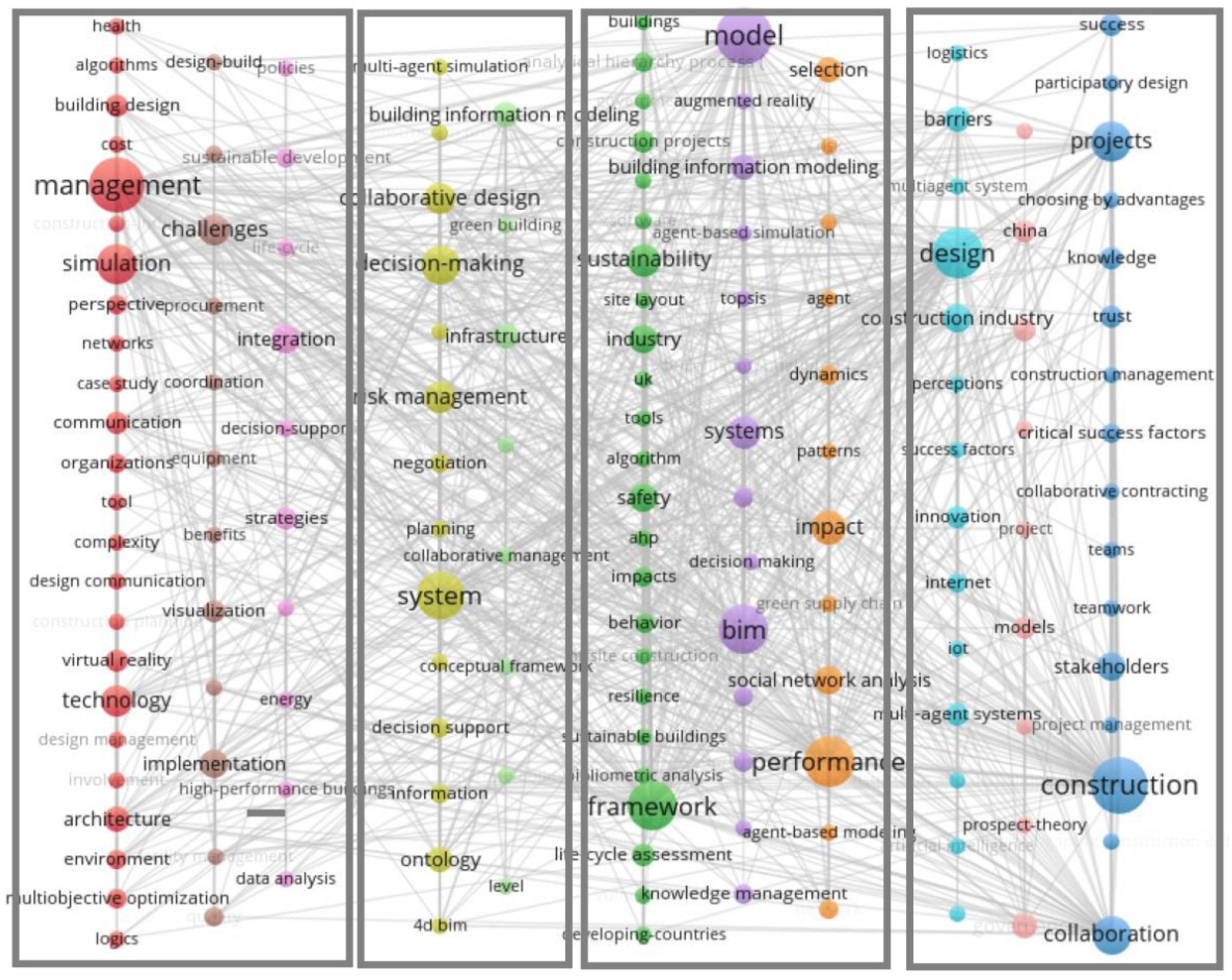
| ID | SOURCE | NUMBER |
|---|---|---|
| 1 | Architectural Engineering and Design Management | 16 |
| 2 | Journal of Construction Engineering and Management | 8 |
| 3 | Automation In Construction | 8 |
| 4 | Building and Environment | 7 |
| 5 | Buildings | 6 |
| 6 | Construction Innovation-England | 5 |
| 7 | Construction Management and Economics | 4 |
| 8 | Energies | 4 |
| 9 | Engineering Construction and Architectural Management | 3 |
| 10 | Frontiers of Engineering Management | 3 |
| 11 | IEEE Access | 3 |
| 12 | International Journal of Construction Management | 2 |
| 13 | International Journal of Disaster Risk Reduction | 2 |
| 14 | Journal of Building Engineering | 2 |
| 15 | Journal of Civil Engineering and Management | 2 |
| 16 | Journal of Computing in Civil Engineering | 2 |
| 17 | Journal of Information Technology in Construction | 2 |
| 18 | Journal of Legal Affairs and Dispute Resolution in Engineering and Construction | 2 |
| 19 | Journal of Management in Engineering | 2 |
| 20 | Safety Science | 2 |
| 21 | Smart and Sustainable Built Environment | 2 |
| 22 | Sustainability | 4 |
| 23 | Sustainable Cities and Society | 2 |
| ID | Country | Documents |
|---|---|---|
| 1 | China | 44 |
| 2 | USA | 21 |
| 3 | Australia | 17 |
| 4 | United Kingdom | 11 |
| 5 | Canada | 10 |
| 6 | Malaysia | 7 |
| 7 | Netherlands | 7 |
| 8 | Egypt | 5 |
| 9 | France | 4 |
| 10 | New Zealand | 4 |
| 11 | Singapore | 4 |
| 12 | Switzerland | 4 |
| Project Number | Design | Construction | Decision-Making | Cost | Production | Information Data | Simulation | Collaboration | Reference |
|---|---|---|---|---|---|---|---|---|---|
| 1 | √ | √ | [6] | ||||||
| 2 | √ | √ | √ | [9] | |||||
| 3 | √ | [10] | |||||||
| 4 | √ | √ | [11] | ||||||
| 5 | √ | √ | [17] | ||||||
| 6 | √ | √ | [18] | ||||||
| 7 | √ | [20] | |||||||
| 8 | √ | √ | √ | √ | [29] | ||||
| 9 | √ | √ | √ | [31] | |||||
| 10 | √ | √ | [32] | ||||||
| 11 | √ | √ | √ | [35] | |||||
| 12 | √ | √ | [36] | ||||||
| 13 | √ | √ | [37] | ||||||
| 14 | √ | √ | [38] | ||||||
| 15 | √ | √ | √ | √ | [39] | ||||
| 16 | √ | √ | √ | [40] | |||||
| 17 | [41] | ||||||||
| 18 | √ | √ | √ | [42] | |||||
| 19 | √ | √ | [43] | ||||||
| 20 | √ | √ | [44] | ||||||
| 21 | √ | √ | √ | √ | [45] | ||||
| 22 | √ | √ | [46] | ||||||
| 23 | √ | √ | √ | √ | [47] |
Disclaimer/Publisher’s Note: The statements, opinions and data contained in all publications are solely those of the individual author(s) and contributor(s) and not of MDPI and/or the editor(s). MDPI and/or the editor(s) disclaim responsibility for any injury to people or property resulting from any ideas, methods, instructions or products referred to in the content. |
© 2024 by the authors. Licensee MDPI, Basel, Switzerland. This article is an open access article distributed under the terms and conditions of the Creative Commons Attribution (CC BY) license (https://creativecommons.org/licenses/by/4.0/).
Share and Cite
Hu, Y.; Wu, L.; Li, N.; Zhao, T. Multi-Agent Decision-Making in Construction Engineering and Management: A Systematic Review. Sustainability 2024, 16, 7132. https://doi.org/10.3390/su16167132
Hu Y, Wu L, Li N, Zhao T. Multi-Agent Decision-Making in Construction Engineering and Management: A Systematic Review. Sustainability. 2024; 16(16):7132. https://doi.org/10.3390/su16167132
Chicago/Turabian StyleHu, Yifei, Liu Wu, Ni Li, and Tianwei Zhao. 2024. "Multi-Agent Decision-Making in Construction Engineering and Management: A Systematic Review" Sustainability 16, no. 16: 7132. https://doi.org/10.3390/su16167132
APA StyleHu, Y., Wu, L., Li, N., & Zhao, T. (2024). Multi-Agent Decision-Making in Construction Engineering and Management: A Systematic Review. Sustainability, 16(16), 7132. https://doi.org/10.3390/su16167132





